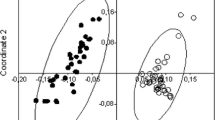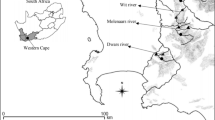Abstract
We investigated the composition and specialisation of shredder chironomids in an invasive white ginger lily (Hedychium coronarium) and in native pickerelweed (Pontederia cordata) leaves. We assumed that the difference of the chemical compound in macrophyte leaves would influence the shredder specialisation. A colonisation experiment was performed over 3 years (2013–2015) using 40 bags for each macrophyte species. The main macrophyte leaf chemical compounds (organic matter, nitrogen, phosphorus, cellulose, lignin, soluble polyphenols and soluble carbohydrates) were measured. The herbivore specialisation was estimated using the individual specialisation index (d′) and community specialisation index (H2′). White ginger lily had higher nitrogen and organic matter, resulting in a higher abundance of shredder specimens and lower specialisation than in native leaves. The Polypedilum fallax group, Stenochironomus and Endotribelos calophylli presented high individual specialisation (d′) in pickerelweed leaves, resulting in high community specialisation (H2′). The heterotrophic facilitation hypothesis explained the herbivores thriving in pickerelweed leaves due to their lower nutritional value. The intake-efficiency hypothesis explained the higher consumption of invasive plant tissue by Stenochironomus, due to its mining habit. We found evidence of evolutionary adaptation of freshwater herbivore eating habits.



Similar content being viewed by others
References
Association of Official Agricultural Chemists, 1995. Official Methods of Analysis of the AOAC. AOAC International, Arlington: 1–30.
Bakker, E. S., K. A. Wood, J. F. Pagès, G. C. Veen, M. J. Christianen, L. Santamaría, B. A. Nolet & S. Hilt, 2016. Herbivory on freshwater and marine macrophytes: A review and perspective. Aquatic Botany 135: 18–36.
Biasi, C., A. M. Tonin, R. M. Restello & L. U. Hepp, 2013. The colonisation of leaf litter by Chironomidae (Diptera): the influence of chemical quality and exposure duration in a subtropical stream. Limnologica-Ecology and Management of Inland Waters 43: 427–433.
Borkent, A., 1984. The systematics and phylogeny of the Stenochironomus complex (Xestochironomus, Harrisius, and Stenochironomus) (Diptera: Chironomidae). Memoirs of the Entomological Society of Canada 116: 5–270.
Boyero, L., L. A. Barmuta, L. Ratnarajah, K. Schmidt & R. G. Pearson, 2012. Effects of exotic riparian vegetation on leaf breakdown by shredders: a tropical–temperate comparison. Freshwater Science 31: 296–303.
Blüthgen, N., F. Menzel & N. Blüthgen, 2006. Measuring specialization in species interaction networks. BMC Ecology 6: 1–12.
Carlsson, N. O. & J. O. Lacoursiere, 2005. Herbivory on aquatic vascular plants by the introduced golden apple snail (Pomacea canaliculata) in Lao PDR. Biological Invasions 7: 233–241.
Carreira, B. M., M. P. Dias & R. Rebelo, 2014. How consumption and fragmentation of macrophytes by the invasive crayfish Procambarus clarkii shape the macrophyte communities of temporary ponds. Hydrobiologia 721: 89–98.
Choi, C., C. Bareiss, O. Walenciak & E. M. Gross, 2002. Impact of polyphenols on growth of the aquatic herbivore Acentria ephemerella. Journal of Chemical Ecology 28: 2245–2256.
Chung, N. & K. Suberkropp, 2009. Contribution of fungal biomass to the growth of the shredder Pycnopsyche gentilis(Trichoptera: Limnephilidae). Freshwater Biology 54: 2212–2224.
Clarke, K. R., 1993. Non-parametric multivariate analyses of changes in community structure. Austral Journal of Ecology 18: 117–143.
Coelho-Silva, J. F., 1967. Noções Sobre Análise de Alimentos. Imprensa Universitária da Universidade Rural do Estado de Minas Gerais, Viçosa.
Corbi, J. J. & S. Trivinho-Strixino, 2017. Chironomid species are sensitive to sugarcane cultivation. Hydrobiologia 785: 91–99.
Cornut, J., V. Ferreira, A. L. Gonçalves, E. Chauvet & C. Canhoto, 2015. Fungal alteration of the elemental composition of leaf litter affects shredder feeding activity. Freshwater Biology 60: 1755–1771.
de Castro, W. A. C., R. V. Almeida, M. B. Leite, R. H. Marrs & D. M. S. Matos, 2016. Invasion strategies of white ginger lily (Hedychium coronarium) J. König (Zingiberacea) under different competitive and environmental conditions. Environment and Experimental Botany 127: 55–62.
Dormann, C. F., J. Fruend, B. Gruber, M. C. F. Dormann & T. R. U. E. LazyData, 2016. Package ‘bipartite’.
Dubois, M., K. A. Gilles, J. K. Hamilton, P. A. Rebers & F. Smith, 1956. Colorimetric method for determination of sugars and related substances. Analytical Chemistry 28: 350–356.
Friedlin, B. & J. L. Gastwirth, 2000. Should the median test be retired from general use? The American Statistician 54: 161–164.
Gonçalves Jr., J. F., R. S. Rezende, J. França & M. Callisto, 2012. Invertebrate colonization during leaf processing of native, exotic and artificial detritus in a tropical stream. Marine and Freshwater Research 65: 428–439.
Hammer, Ø., D. A. T Harper & P. D. Ryan, 2001. PAST: paleontological statistics software package for education and data analysis. Palaeontologia Electronica 4(1): 9 pp.
König, R., L. U. Hepp & S. Santos, 2014. Colonisation of low-and high-quality detritus by benthic macroinvertebrates during leaf breakdown in a subtropical stream. Limnologica-Ecology and Management of Inland Waters 45: 61–68.
Koroiva, R., C. W. O. Souza, D. Toyama, F. Henrique-Silva & A. A. Fonseca-Gessner, 2013. Lignocellulolytic enzymes and bacteria associated with the digestive tracts of Stenochironomus (Diptera: Chironomidae) larvae. Genetics and Molecular Research 12: 3421–3434.
Kozovtis, A. R., M. M. C. Bustamente, C. R. Garofalo, S. Bucci, A. C. Franco, G. Goldstein & F. C. Meinzer, 2007. Nutrient reabsorption and patterns of litter production and decomposition in a Neotropical Savanna. Functional Ecology 21: 1034–1043.
Kubanek, J., M. E. Hay, P. J. Brown, N. Lindquist & W. Fenical, 2001. Lignoid chemical defenses in the freshwater macrophyte Saururus cernuus. Chemoecology 11: 1–8.
Kuehne, L. M., J. D. Olden & E. S. Rubenson, 2016. Multi-trophic impacts of an invasive aquatic plant. Freshwater Biology 61: 1846–1861.
Leite-Rossi, L. A. & S. Trivinho-Strixino, 2012. Are sugarcane leaf-detritus well colonized by aquatic macroinvertebrates? Acta Limnologica Brasiliensia 24: 303–313.
Leite-Rossi, L. A., V. S. Saito, M. B. Cunha-Santino & S. Trivinho-Strixino, 2016. How does leaf litter chemistry influence its decomposition and colonization by shredder Chironomidae (Diptera) larvae in a tropical stream? Hydrobiologia 77: 119–130.
Lodge, D. M., 1991. Herbivory on freshwater macrophytes. Aquatic Botany 41: 195–224.
Lorenzi, H., 1991. Plantas daninhas do Brasil: terrestres, aquáticas, parasitas, tóxicas e medicinais. Instituto Plantarum, Nova Odessa.
Lorenzi, H. & H. Souza, 2001. Plantas ornamentais. Plantarum, São Paulo.
Makkar, H. P., M. Blümmel, N. K. Borowy & K. Becker, 1993. Gravimetric determination of tannins and their correlations with chemical and protein precipitation methods. Journal of the Science of Food and Agriculture 61: 161–165.
Martin-Creuzburg, D., B. Beck & H. M. Freese, 2011. Food quality of heterotrophic bacteria for Daphnia magna: evidence for a limitation by sterols. FEMS Microbiology Ecology 76: 592–601.
Matsuda, J. T., F. A. Lansac-Tôha, K. Martens, L. F. M. Velho, R. P. Mormul & J. Higuti, 2015. Association of body size and behavior of freshwater ostracods (Crustacea, Ostracoda) with aquatic macrophytes. Aquatic Ecology 49: 321–331.
Mertens, D. R., 2002. Gravimetric determination of amylase treated neutral detergent fiber in feeds with refluxing in beaker or crucibles: collaborative study. Journal of AOAC International 85: 1217–1240.
Morrison, W. E. & M. E. Hay, 2011a. Induced chemical defenses in a freshwater macrophyte suppress herbivore fitness and the growth of associated microbes. Oecologia 165: 427–436.
Morrison, W. E. & M. E. Hay, 2011b. Herbivore preference for native vs. exotic plants: generalist herbivores from multiple continents prefer exotic plants that are evolutionarily naïve. PLoS One 6: e17227.
Morrison, W. E. & M. E. Hay, 2012. Are lower-latitude plants better defended? Palatability of freshwater macrophytes. Ecology 93: 65–74.
Provenza, F. D., J. J. Villalba, L. E. Dziba, S. B. Atwood & R. E. Banner, 2003. Linking herbivore experience, varied diets, and plant biochemical diversity. Small Ruminant Research 49: 257–274.
R Development Core Team, 2014. R: A Language and Environment for Statistical Computing. R Foundation for Statistical Computing, Vienna, Austria [available on internet at http://www.R-project.org] (accessed 26.10.16).
Robertson, J. B. & P. J. Van Soest, 1981. The detergent system of analysis and its application to human foods. In James, W. P. T. & O. Theander (eds), The Analysis of Dietary Fiber in Food. Marcel Deller, New York: 123–158.
Sanchez, J. L. & J. C. Trexler, 2016. The adaptive evolution of herbivory in freshwater systems. Ecosphere. https://doi.org/10.1002/ecs2.1414.
Sarruge, J. R. & H. P. Haag, 1974. Análises Químicas em Plantas, Escola Superior de Agricultura Luiz de Queiroz. Universidade de São Paulo, Piracicaba.
Saulino, H. H. L., J. J. Corbi & S. Trivinho-Strixino, 2014. Aquatic insect community structure under the influence of small dams in a stream of the Mogi-Guaçu river basin, state of São Paulo. Brazilian Journal of Biology 74: 79–88.
Theel, H. J., E. D. Dibble & J. D. Madsen, 2008. Differential influence of a monotypic and diverse native aquatic plant bed on a macroinvertebrate assemblage: an experimental implication of exotic plant induced habitat. Hydrobiologia 600: 77–87.
Tiner, R. W., 1991. The concept of a hydrophyte for wetland identification. Bioscience 41: 236–247.
Trivinho-Strixino, S., 2014. Ordem Diptera. Família Chironomidae. Guia de identificação de larvas. In Hamada, N., J. L. Nessimian, & R. B. Querino (eds), Insetos Aquáticos na Amazônia brasileira: taxonomia, biologia e ecologia. Editora do INPA, Manaus: 457–660
Zenni, R. D. & S. R. Ziller, 2011. An overview of invasive plants in Brazil. Brazilian Journal of Botany 34: 431–446.
Wetzel, R. G., 1983. Limnology, 2nd ed. W. B. Saunders, Philadelphia.
Wong, P. K., Y. A. N. Liang, N. Y. Liu & J. W. Qiu, 2010. Palatability of macrophytes to the invasive freshwater snail Pomacea canaliculata: differential effects of multiple plant traits. Freshwater Biology 55: 2023–2031.
Wood, K. A., M. T. O’Hare, C. McDonald, K. R. Searle, F. Daunt & R. A. Stillman, 2016. Herbivore regulation of plant abundance in aquatic ecosystems. Biological Reviews. https://doi.org/10.1111/brv.12272.
Acknowledgements
We would like to thank the Brazilian National Council for Technological and Scientific Development (CNPq) for the financial support throughout the research project process 141020/2013. Susana Trivinho-Strixino has a productivity grant awarded by CNPq (Process Number: 306402/2010-6). We would also like to thank Rebecca Clement from Brigham Young University who provided the first English language reviews.
Author information
Authors and Affiliations
Contributions
Saulino, HHL and Trivinho-Strixino, S designed the experiments and wrote the manuscript. Saulino, HHL performed the experiments and analysed the dates.
Corresponding author
Ethics declarations
Ethical approval
All applicable international, national, and/or institutional guidelines for the care and use of animals were followed.
Additional information
Handling editor: María del Mar Sánchez-Montoya
Rights and permissions
About this article
Cite this article
Saulino, H.H.L., Trivinho-Strixino, S. Native macrophyte leaves influence more specialisation of neotropical shredder chironomids than invasive macrophyte leaves. Hydrobiologia 813, 189–198 (2018). https://doi.org/10.1007/s10750-018-3525-z
Received:
Revised:
Accepted:
Published:
Issue Date:
DOI: https://doi.org/10.1007/s10750-018-3525-z




